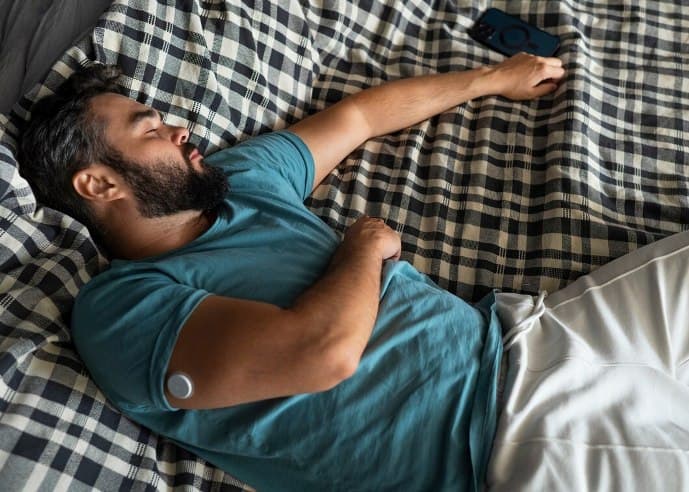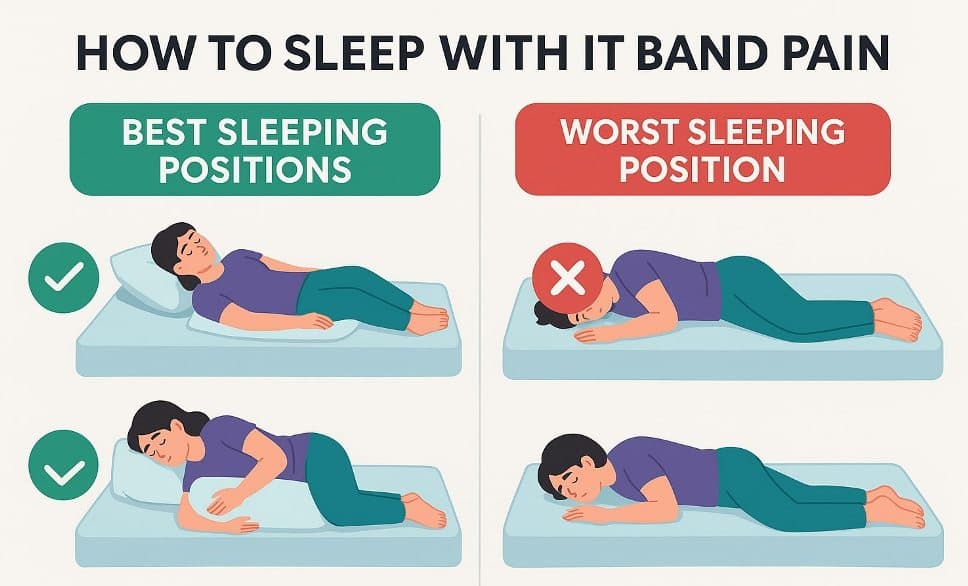How to Sleep with IT Band Pain: Best Positions and Tips
IT band pain might make it difficult to get a good night’s sleep. IT band discomfort is brought on by tightness or inflammation in the iliotibial band, a ligament that runs along the outside of the thigh. Athletes and runners frequently experience this soreness.
Insufficient sleep can exacerbate the discomfort, resulting in a vicious cycle. The secret to getting better sleep is knowing how to deal with this pain.
We’ll look at some suggestions for improving your sleep in this post. You’ll learn simple strategies to ease discomfort and promote healing.
Whether your pain is mild or severe, these tips aim to help you find relief and get a good night’s sleep. Read on to discover how you can sleep comfortably, even with IT band pain.
Table of Contents
Why IT Band Pain Gets Worse at Night
You might wonder why your IT band pain feels more intense when you’re trying to rest. Here are the main reasons:
- Lack of movement causes the muscles and fascia to stiffen.
- Poor sleep positioning may put the IT band in a stretched or compressed state.
- Inflammation often increases at night, especially after a full day of activity.
- Low body awareness while asleep can lead to aggravating movements or postures.
That’s why it’s essential to prepare your body before bed, sleep in joint-friendly positions, and support healing throughout the night.
Read Also: Home Remedies for Cuboid Bone Pain Relief
The Best Sleep Positions for IT Band Pain Relief
Choosing the correct sleep position can significantly reduce IT band strain and allow the inflamed tissues to rest.
Back Sleeping with Knee Support
Sleeping on your back helps maintain a neutral spine and hip alignment, which reduces the stress placed on your IT band. To maximize comfort:
- Place a pillow or bolster under your knees to slightly elevate them.
- Ensure your feet naturally fall outward without forced rotation.
- Use a medium-loft pillow to support your neck and keep the spine aligned.
This position helps avoid excessive hip adduction or external rotation, which can irritate the IT band.
Side Sleeping with Strategic Pillow Placement
If you prefer to sleep on your side:
- Always sleep on the non-affected leg.
- Use a thick, supportive pillow between your knees and ankles to prevent your top leg from rotating inward.
- Keep your knees slightly bent, not fully curled.
- Consider a full-length body pillow to help maintain position all night.
Avoid letting your top leg fall forward or behind the bottom leg — this increases strain across the hip and knee, pulling on the IT band.
Check Also: Cervical Pillow For Neck And Shoulder
Avoid Stomach Sleeping at All Costs
Stomach sleeping forces your hips into external rotation and flattens the lumbar curve, pulling on the IT band and creating tension across the entire lateral thigh. It can also strain your neck and lower back, which only amplifies discomfort.
Pre-Sleep Routine: Stretching and Mobility for IT Band Relief
Winding down with a gentle, focused stretching routine can prepare your muscles for rest and release tension from the IT band and surrounding structures.
Recommended Stretches (Hold each for 30–60 seconds)
Standing Cross-Leg Stretch
- Stand tall and cross the painful leg behind the other.
- Reach toward the side opposite the affected leg until you feel a stretch along the outer hip and thigh.
- Keep your hips square and avoid bending forward.
Reclining Figure-Four Stretch
- Lie on your back.
- Cross the ankle of the painful leg over the opposite knee.
- Gently pull the bottom leg toward your chest while keeping your back flat.
Wall-Assisted Hip Flexor Stretch
- Kneel with one leg forward, creating a 90-degree angle.
- Tuck your pelvis and push your hips forward.
- If possible, add a lateral lean away from the affected side to target the TFL (tensor fasciae latae) and upper IT band.
Foam Rolling Techniques (Use with caution)
While direct foam rolling on the IT band is often too aggressive, you can safely roll:
- Glutes (especially the gluteus medius)
- Tensor Fasciae Latae (TFL)
- Outer quadriceps
Use slow, controlled movements, and avoid rolling over painful areas directly. This helps loosen the connective tissue without aggravating inflammation.
Nighttime Pain Management Strategies
Dealing with IT band pain at night requires simple, effective techniques to reduce inflammation and relax muscles before bed:
Cold Therapy
Apply a cold pack to the painful area 15–20 minutes before bed. Cold reduces swelling and provides a numbing effect to dull sharp pain. Always use a towel or cloth to prevent frostbite.
Over-the-Counter Anti-Inflammatories
Taking ibuprofen or naproxen sodium (NSAIDs) 30 minutes before bed can reduce inflammation and help you fall asleep more easily. Use them responsibly and consult a healthcare provider for long-term use.
Natural Remedies
Natural remedies are an alternative to traditional medication. Turmeric supplements can reduce inflammation. Its active ingredient, curcumin, is known for its anti-inflammatory properties. Fish oil is another option. Omega-3 fatty acids can help manage pain.
Magnesium supplements can aid muscle relaxation. Taking magnesium before bed may ease muscle tightness. Herbal teas like chamomile or valerian root can promote relaxation and improve sleep quality.
Don’t forget about essential oils. Lavender oil can help reduce pain and promote sleep. A few drops on your pillow might make a difference.
Topical Treatments and Magnesium
- Use a topical analgesic cream (like menthol or arnica-based gels) on the outer thigh.
- Spray or rub in magnesium oil to help relax tight muscles.
- Consider a warm Epsom salt bath before bed to soothe the body and aid sleep.
Mattress and Pillow Support: Set Up for Recovery
The wrong mattress can intensify IT band symptoms overnight. Here’s how to optimize your sleep surface:
Mattress Recommendations
- A medium-firm mattress that conforms to your body’s shape helps avoid knee and hip pain spots.
- Avoid mattresses that sag or are too soft — these misalign the spine and pelvis.
- Memory foam or latex options offer pressure relief and spinal support.
Pillow Support
- Knee pillows for side sleepers reduce torque across the hips.
- A lumbar pillow under the lower back while back sleeping can support spinal curvature.
- Body pillows prevent unwanted movement during the night.
During-the-Day Tips to Prevent Nighttime Flare-Ups
Managing your IT band pain during the day directly impacts how you feel at night. These daytime habits promote healing and reduce tension:
- Avoid prolonged sitting or standing—alternate positions frequently.
- Don’t sit with legs crossed, as this shortens and tightens the IT band.
- Perform low-impact exercises like swimming or elliptical use instead of running.
- Strengthen the gluteus medius, hip abductors, and core through targeted physical therapy exercises.
- Drink plenty of water and eat anti-inflammatory foods (like turmeric, salmon, leafy greens, berries).
Final Thoughts
Sleep can be tough with IT band pain. But small changes help. With the right combination of supportive sleep posture, nightly stretching, pain relief strategies, and daytime management, you can protect your IT band while you sleep and promote faster healing.
Good sleep is vital for recovery. So, explore options that suit your body. Better nights are possible with patience and care. Remember, your comfort matters most. Keep prioritizing it.

